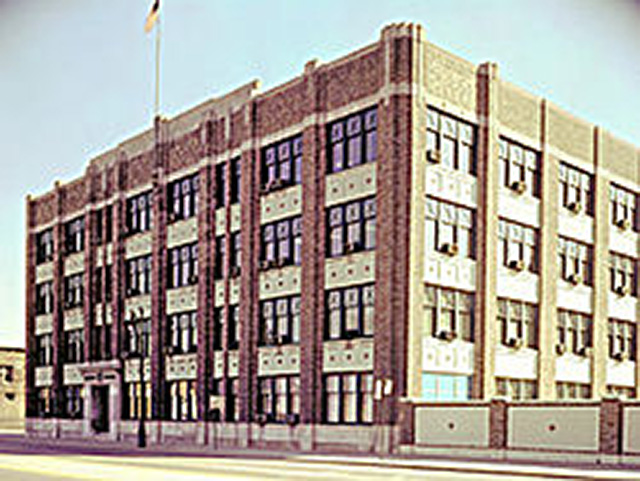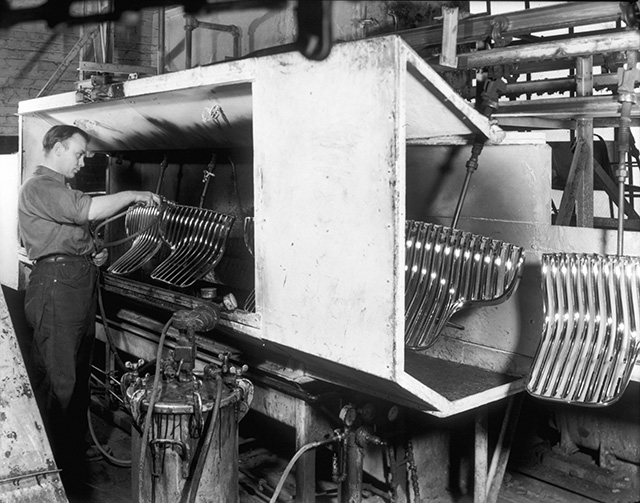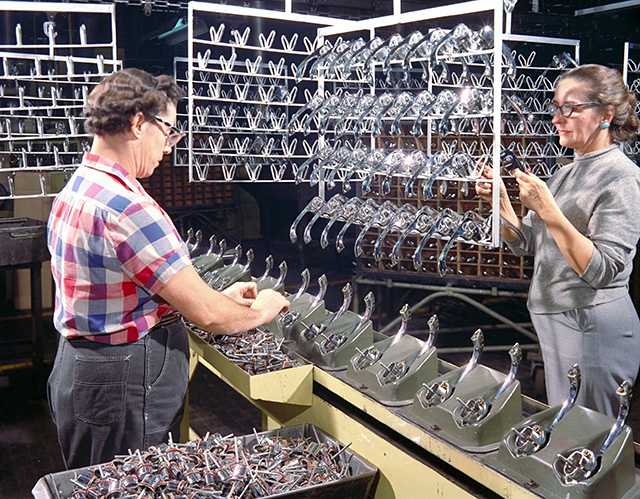
Ternstedt was named after its founder, Alvar K. Ternstedt, who invented and patented a chain and sprocket mechanism for windows. This replaced, in short order, the inefficient system of raising and lowering auto windows by straps. Needing financial backing, Ternstedt invited the Fisher brothers—already the largest body building firm in the world—to join him. In 1917 the Ternstedt Manufacturing Company incorporated, with Ternstedt as chairman and the other seven directors - shareholders, into the Fisher Body Corporation.
By 1920, shortly after Ternstedt’s death, Fisher Body acquired the plant. Within the year the personnel and machinery for manufacturing all Fisher Body hardware was moved to the site. This required constructing additional buildings but also incorporated the work of two independent manufacturers—the England Manufacturing Company, which made rolled shapes and stampings, and the International Metal Stamping Company, which built truck cabs, fenders and large stampings. From then until 1926 Ternstedt turned out heavy stampings including fenders, radiator shells and door panels.
In 1923 Ternstedt acquired the Shepard Art Metal Company, which allowed it to expand into production of outside door handles and interior hardware (footrests, dome lines, regulator handles, ash trays, etc.) Designing art metal work became a Ternstedt specialty.
 Ternstedt Administration Building - West Fort Street (1948)
Ternstedt Administration Building - West Fort Street (1948)
Ternstedt was always closely tied to the Fisher Fleetwood plant on West End, which produced bodies for General Motors, and to the Cadillac plant at Clark Street. In fact, styling and engineering flowed seamlessly across the three plants. By 1926, when General Motors acquired Fisher Body, Ternstedt was already producing all the hardware for “Bodies by Fisher.” Almost 40% of the parts Ternstedt produced, were covered by interior trim and never seen by auto owners. However, they were essential elements to the car, including the door lock unit and cowl ventilator mechanisms. Known as the Ternstedt Manufacturing Division, General Motors Corporation, the site also manufactured hardware for boats, ice boxes and other auto companies.
As part of manufacturing unique brands, auto corporations used decorative hood ornaments/radiator caps to help give their products a distinctive identity. These were in a shiny finish that made the cars look new year after year. Ternstedt was the industry leader in automotive trim design, proclaiming in ads that it “affords the industry a distinctive means of individualizing modern motor cars. Visitors at the National Automobile Shows will have an opportunity to observe designs far removed from the usual and commonplace. The skillful handling and fine artistry of these original creations fittingly express the personality of the cars upon which they appear.”
Insert: GM 4 (1930 LaSalle Goddess Hood Ornament)) - Insert Caption: William Schnell’s 1930 LaSalle Goddess Hood Ornament
Heading up the Ternstedt Art & Color department and the Die Sinker Department from 1924 to 1935, William Schnell designed and patented more than thirty hood ornaments and trim designs, mentoring other Ternstedt designers as well. Perhaps his most famous mascot is the 1930 Cadillac/LaSalle Goddess, a sleek Art Deco design. He also designed classic mascots for other GM divisions and for non-GM companies, including the nude figures for Pierce Arrow. These mascots were produced by a coating system that consisted of copper, nickel and chrome.
From the 1920s through the 1960s the Ternstedt plant on West Fort at Livernois was the largest manufacturer of automobile hardware in the world, with approximately 8,000 employees. Over the years other plants were built in Trenton, New Jersey; Livonia and Flint, Michigan; Columbus and Elyria, Ohio; and Syracuse, New York. By 1968 Ternstedt operated seven plants, had nearly 25,000 employees and produced 400 auto products. These included door handles, locks, window regulators, radiator grills, wheel covers and trim parts. One employee, recalling the variety of the manufacturing processes, wrote of “high speed presses doing heavy metal stamping, rolling mills, benders that did bright metal plate, anodize, paint, injection molding with small assembly lines, die cast molding and soft trim.”
 Door Handle Production Line
Door Handle Production Line
During World War II the Fort Street plant produced anti-aircraft gun Breech housings, gun synchronizers, gun sights, aircraft parts, Sperry gyroscopes, exhaust manifold assemblies for the B-17 air precision indicator, turrets for tanks and cars, cutting tools, M-4 and Fisher tank parts among other items for war production. It received the Army-Navy E Award.
Ternstedt had first hired women during World War I and continued to employ them given the stereotype that women could more easily handle the small parts it manufactured. Even married women found work there—but of course women employees were also paid less than men. By 1930 half of all the Detroit women working in the auto industry worked at Ternstedt.
After the 44-day sit-down at Flint’s General Motors plant, the company recognized the UAW in early 1937. But at Ternstedt the plant manager did not want to negotiate with the union so the workers held a number of slowdowns that spring. By June, Ternstedt Manufacturing Division agreed to abolish piecework and instituted rates for jobs that reduced the power of foremen. This was particularly important given the number of women workers who faced sexual harassment at the hands of foremen.
Before World War II, half of the women employed at Ternstedt were American-born Poles (and a few Hungarians and Slovenians). The other half were white Southerners who came to Detroit after the collapse of the coal industry in 1929. The men were predominately from the skilled trades and included former coal miners. It was only in the 1960s that African Americans, both men and women, were hired.
Following the war Ternstedt’s name became Fisher Body-Ternstedt Division. Two years later it became a separate division only to be reunited with Fisher Body in 1968. Its headquarters was transferred in 1962 to the GM Tech Center. In that same year Brown-Lipe-Chapin, a supplier of differential gears for GM and acquired as far back as 1922, was consolidated with the Ternstedt division.
 Door Handle Production Line
Door Handle Production Line
By the 1980s production was outmoded at the Clark Street Cadillac and Fisher Body plants—both at Ternstedt and West End. In 1984 Fisher Body was dissolved and merged with other GM operations. Ternstedt’s contribution to “Body by Fisher” and the Cadillac image has been widely recognized as its distinctive styling and excellent craftsmanship.
Click to view:
Automotive Decorative Plating, Dr. James H. Lindsay’s slide show highlighting the early years of surface coating technology posted at the Product Finishing website.
Ternstedt Women Organize, a feature from the Michigan Labor History Society Newsletter highlighting the campaign by UAW supporters to organize immediately following the signing of the first contract with GM in 1937
Text & RESEARCH - Dianne Feeley
IMAGES
Detroit Historical Society
Ternstedt Billboard
General Motors Media Archives
All Images



